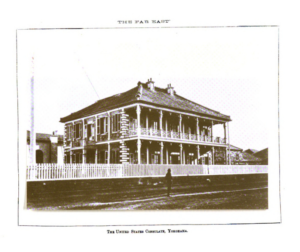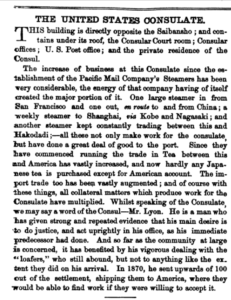The first chapter of Reading Bangkok explores the historical origins of Bangkok from the fall of the Ayutthaya kingdom towards the early 20th century. Ross King’s primary argument lays upon the idea that Bangkok (and by extension, Siam) holds a dualistic identity, a surface level (masked) identity and an internal identity.[1] Bangkok’s ethno-religious diversity of Buddhist Thai, Lao, Khmer, Muslim Patani, Christian-Portuguese and Chinese serve the foundation of Bangkok’s internal identity, not predicated on any singular ethno-religious background. While on the surface, rigid and homogeneous notions of a singular ‘Siamese’ identity upheld barriers to distinguish the local from the foreign in the name of European-inspired ‘modernity’.
I would argue that this phenomenon of masking diversity is evident in other cities of Southeast Asia, namely Malacca (and, by extension, Malaysia). The colonial administration encouraged the construction of separate and rigid ethno-religious identities, providing them the agency to define the parameters of a grand ‘Malayan’ identity.
Sin Yee Koh highlights that Malaysia’s ethno-religious diversity has been masked by a rigid Malay-centric vision of Malaysian identity.[2] Unlike Siam, this surface-level identity has not been applied through local, elite-driven movements towards ‘modernity’ but by British-driven efforts to homogenise Malaysia’s diverse population under an anglo-centric understanding of ‘Malayan identity’.
This is exemplified in Thomas Newbold’s 1839 Political and Statistical account of British Settlements in the Straits of Malacca, namely, Malacca. Newbold acknowledges Malacca’s ethno-religious diversity, however, it appears that his census has inconsistencies with broadly constructed identities that appear to segregate and simplify the city’s population. Newbold incorporates the diverse peninsular Malay, Acehnese, Moluccan and Bugi population under a broad Malay category.[3] But at the same time, he produces a specific ‘Javanese’ category despite its similar origins to the broadly defined ‘Malay’ ethnic group.[4] Additionally, Newbold includes both broad religious and ethnic groups within his census to categorise people of unidentifiable or fluid backgrounds. Those with South-Asian ancestry that do not fit under the ‘Chuliah’ or ‘Bengali’ categories were identified as ‘Hindoo’.[5] Those who were not identified as ‘European’ but followers of the Christian faith (no matter what ethnic group) fit under the broad Christian category.[6]
This census highlights two ideas. Firstly, the colonial administration failed to provide agency to Malacca’s internal diversity and created broad categories that compartmentalised the city’s population for easier administration. Secondly, the desire for simplification highlights a highly rigid notion of identity, one that disregards demographic fluidity for concretely define categories of identification.
The colonial administration was arguably not blind towards Malacca’s internal diversity as Newbold does acknowledge local Eurasian populations. However, this fluidity is disregarded as a form of ‘impurity’. The Portuguese-descent population, which have resided in Malacca for 400 years and are highly inter-mixed with the peninsular Malay and Chinese populations, are regarded as ‘degenerated’ and ‘impoverished’.[7] However, the Dutch population are deemed ‘respectable’ due to their ‘pure’ lineage to elite officers of the previous Dutch colonial government in Malacca.[8]
As the colonial administration engaged in the segregation of Malacca’s demographic diversity, this provided ample agency for the administration to construct an understanding of a broader ‘Malayan’ identity. Newbold creates a dichotomous relationship between the ‘native’ and the ‘foreigner’, with the peninsular Malay population labelled as ‘native’ and all other populations seen as ‘foreign’.[9] This constructed identity removes agency from the domestic population and provides power to the colonial administration to define Malayan identity for themselves.
Koh’s analysis supports this as the colonial administration’s assertion of what it meant to be ‘native’ constructed a national identity that emphasised the importance of the ‘native’ Malay over the ‘foreign’ Chinese and Indian population.[10] Much like in Siam, a homogenous identity masked Malaya’s internal demographic diversity under rigid definitions of race and religion, emphasising the indigenuity of a native ‘Malay’ population as the primary representation of Malayan identity. The ‘mask’ of the ‘native’ dominated nationalist politics and arguably dominates local Malaysian politics today.
Bibliography:
Primary Source:
Newbold, Thomas John, Political and Statistical account of the British Settlements in the Straits of Malacca, viz. Pinang, Malacca and Singapore; with a History of the Malayan States on the Peninsula of Malacca, vol. 1. (London, 1839).
Secondary Sources:
King, Ross, Reading Bangkok (Hawaii, 2011).
Koh, Sin Yee, Race, Education and Citizenship: Mobile Malaysians, British Colonial Legacies, and a Culture of Migration (New York, 2017).
[1] Ross King, Reading Bangkok (Hawaii, 2011), p. 1.
[2] Sin Yee Koh, Race, Education and Citizenship: Mobile Malaysians, British Colonial Legacies, and a Culture of Migration (New York, 2017), pp. 88-89.
[3] Thomas John Newbold, Political and Statistical account of the British Settlements in the Straits of Malacca, viz. Pinang, Malacca, and Singapore; with a History of the Malayan States on the Peninsula of Malacca, vol. 1. (London, 1839), p. 136.
[4] Ibid.
[5] Ibid., pp. 136-137.
[6] Ibid.
[7] Ibid., p. 138.
[8] Ibid., pp. 137-138.
[9] Ibid., p. 44.
[10] Koh, Mobile Malaysians, pp. 88-89.

